RBSE Solutions for Class 12 Physics Chapter 3 Current Electricity
Rajasthan Board RBSE Solutions for Class 12 Physics Chapter 3 Current Electricity Textbook Exercise Questions and Answers.
Rajasthan Board RBSE Solutions for Class 12 Physics in Hindi Medium & English Medium are part of RBSE Solutions for Class 12. Students can also read RBSE Class 12 Physics Important Questions for exam preparation. Students can also go through RBSE Class 12 Physics Notes to understand and remember the concepts easily. Browsing through wave optics important questions that include all questions presented in the textbook.
RBSE Class 12 Physics Solutions Chapter 3 Current Electricity
RBSE Class 12 Physics Current Electricity Textbook Questions and Answers
Question 3.1.
A storage battery of a car has an e.m.f. of 12V. If the internal resistance of the battery is 0.4 Ω, what is the maximum current that can be drawn from the battery?
Answer:
Given
E = 12V, r = 0.4 Ω, I = ?
Since I = \(\frac{\mathrm{E}}{r}=\frac{12}{0.4}\) = 30 A

Question 3.2.
A battery of e.m.f 10V and internal resistance 3 Ω is connected to a resistor. If the current in the circuit is 0.5A, what is the resistance of the resistor? What is the terminal voltage of the battery when the circuit is closed?
Answer:
Given
E = 10V, r = 3 Ω, I = 0.5, R = ?
Since V = E - Ir
or V = 10 - 0.5 x 3
or V = 8.5 volt
And R = \(\frac{\mathrm{V}}{1}=\frac{8.5}{0.5}\) = 17 Ω.
Question 3.3.
(a) Three resistors 1 Ω, 2 Ω and 3 Ω are combined in series. What is the total resistance of the combination?
(b) If the combination is connected to a battery of e.m.f. 12V and negligible internal resistance, obtain the potential drop across each resistor.
Answer:
Given
R1 = 1 Ω, R2 = 2 Ω, R3 = 3 Ω
(a) Total resistance of series combination
Rs = R1 + R2 + R3
or Rs = 1 + 2 + 3 = 6 Ω
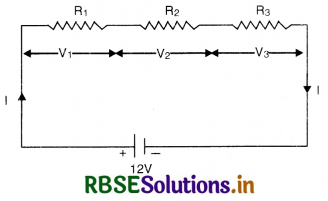
(b) Since E = I(R + r)
∴ I = \(\frac{\mathrm{E}}{\mathrm{R}_s+0}=\frac{\mathrm{E}}{\mathrm{R}_s}\) = 2 A
∴ V1 = IR1 = 2 x 1 = 2 V
V2 = IR2 = 2 x 2 = 4 V
V3 = IR3 = 2 x 3 = 6 V
Question 3.4.
(a) Three resistors 2 Ω, 4 Ω and 5 Ω are combined in parallel. What is the total resistance of the combination?
(b) If the combination is connected to a battery of e.m.f. 20 V and negligible internal resistance, determine the current through each resistor, and the total current drawn from the battery.
Answer:
Given R1 = 2 Ω, R2 = 4 Ω, R3 = 5 Ω
(a) Total resistance in parallel combination
\(\frac{1}{R}=\frac{1}{R_1}+\frac{1}{R_2}+\frac{1}{R_3}\)
or \(\frac{1}{R}=\frac{1}{2}+\frac{1}{4}+\frac{1}{5}\)
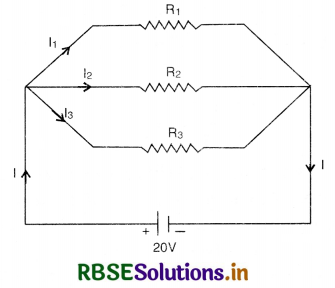
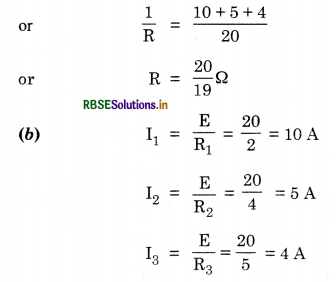
Question 3.5.
At room temperature (27.0°C) the resistance of a heating element is 100 Ω. What is the temperature of the element if the resistance is found to be 117 Ω, given that the temperature coefficient of the material of the resistor is 1.70 x 10-4° C-1?
Answer:
Given
R27 = 100 Ω, Rt = 117 Ω, α = 1.70 x 10-4° C-1, t = ?
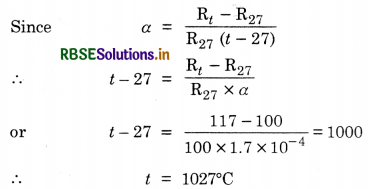

Question 3.6.
A negligibly small current is passed through a wire of length 15 m and uniform cross-section 6.0 x 10-7 m2 and its resistance is measured to be 5.0 Ω. What is the resistivity of the material at the temperature of the experiment?
Answer:
l = 15 m, A = 6.0 x 10-7 m2, R = 5.0 Ω
Applying the relation,
R = ρ\(\frac{l}{\mathrm{~A}}\)
∴ ρ = \(\frac{\mathrm{RA}}{l}=\frac{5 \times 6 \times 10^{-7}}{15}\) = 2 x 10-7 Ωm
Question 3.7.
A silver wire has a resistance of 2.1 Ω at 27.5° C, and a resistance of 2.7 Ω at 100° C. Determine the temperature co-efficient of resistivity of silver.
Answer:
Rt1 = R27.5 = 2.1 Ω and Rt2 = R100 = 2.7 Ω
Applying the relation,
α = \(\frac{\mathrm{R}_{t_2}-\mathrm{R}_{t_1}}{\mathrm{R}_{t_1} \times\left(t_2-t_1\right)}=\frac{2.7-2.1}{2.1 \times 72.5}=\frac{0.7}{2.1 \times 62.5}\)
α = 0.0039° C-1
Question 3.8.
A heating element using nichrome connected to a 230 V supply draws an initial current of 3.2 A which settles after a few seconds to a steady value of 2.8 A. What is the steady temperature of the heating element if the room temperature is 27.0° C? Temperature coefficient of resistance of nichrome averaged over the temperature range involved is 1.70 x 10-4° C-1.
Answer:
Given
V = 230 V, I = 2.8 A
∴ R27 = \(\frac{\mathrm{V}}{\mathrm{I}}=\frac{230}{3.2}\) Ω and Rt = \(\frac{230}{2.8}\) Ω
α = 1.70 x 10-4° C-1
Since α = \(\frac{\mathrm{R}_t-\mathrm{R}_{27}}{\mathrm{R}_{27} \times(t-27)}\)
or t - 27 =\( \frac{\mathrm{R}_t-\mathrm{R}_{27}}{\mathrm{R}_{27} \times \alpha}=\frac{\left(\frac{230}{3.2}\right)-\left(\frac{230}{2.8}\right)}{\frac{230}{2.8} \times 1.7 \times 10^{-4}}\) = 840.2
or t = 840.2 + 27 = 867.2° C
or t = 867° C
Question 3.9.
Determine the current in each branch of the following network:
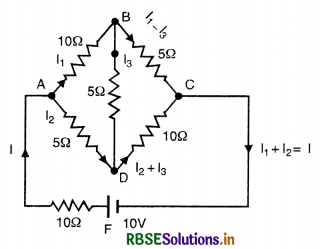
Answer:
Applying Kirchhoff's 2nd law of closed circuits ABD and BCD,
10I1 + 5I3 - 5I2 = 0
or 2I1 + I3 - I2 = 0 ........................(1)
5(I1 - I3) - 10(I2 + I3) - I3 = 0
5I1 - 10I2 - 20I3 = 0
or I1 - 2I2 - 4I3 = 0 .........................(2)
Multiply (1) by 4 and add (2),
I1 - 2I2 - 4I3 = 0
8I1 - 4I2 + 4I3 = 0
9I1 - 6I2 = 0
3I1 - 2I2 = 0 ......................(3)
Again applying Kirchhoff's law to closed ckt ADCBA
10I + 5I2 + 10(I2 + I3) = 10
10 (I1 + I2) + 5I2 + 10 (I2 + I3) = 10
10I1 + 25I2 + 10I3 = 10
2I1 + 5I2 + 2I3 = 2 .................(4)
Multiplying (1) by 2 and subtracting from (4),

Multiplying (3) by 2 and subtracting from (5),
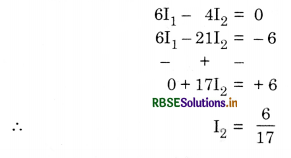
∴ Current through AD = \(\frac{6}{17}\)A.
From (3),
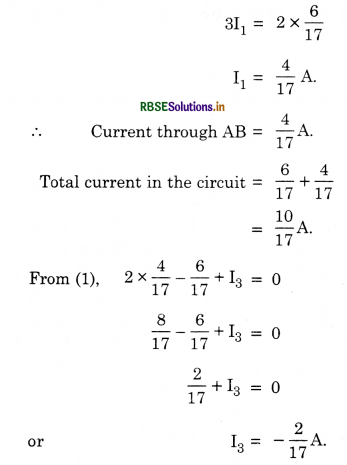
∴Current through DB = \(\frac{12}{17}\)A.
Current through BC = I1 - I3 = \(\frac{4}{17}+\frac{2}{17}=\frac{6}{17}\)A.
Current throught DC = I2 + I3 = \(\frac{6}{17}-\frac{2}{17}=\frac{4}{17}\)A.
Question 3.10.
(a) In a meter bridge the balance point is found to be at 39.5 cm from the end A, when the resistor Y is 12.5 Ω. Determine the resistance of X. Why are the connections between resistors in a Wheatstone or meter bridge made of thick copper strips?
(b) Determine the balance point of the meter bridge if X and Y are interchanged.
(c) What happens if the galvanometer and cell are interchanged at the balance point of the bridge? Would the galvanometer show any current?
Answer:
(a) Given l1 = 39.5, l2 = 100 - 39.5 = 60.5 cm
For a meter bridge, we have
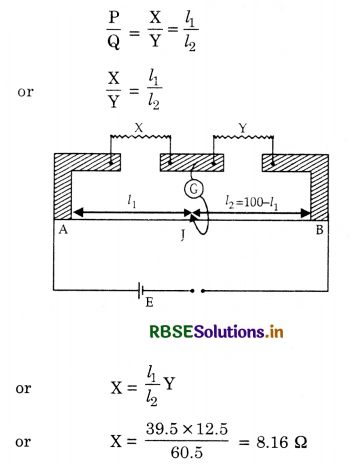
To minimize resistance of the connections which are not accounted for in the bridge formula, we use thick copper strips.
(b) On interchanging X and Y,
\(\frac{\mathrm{P}}{\mathrm{Q}}=\frac{\mathrm{Y}}{\mathrm{X}} or \frac{\mathrm{P}}{\mathrm{Q}}=\frac{12.5}{8.16}\)
or \(\frac{\mathrm{P}}{\mathrm{Q}}=\frac{1.53}{1}\)
P : Q : : 1.53 : 1 or l1 : l2 : : 1.53 : 1
l1 = \(\frac{100 \times 1.53}{2.53}\) = 60.5 cm
Thus the new balance point will be 60.5 cm from A.
(c) The galvanometer will show no current.

Question 3.11.
A storage battery of e.m.f. 8.0 V and internal resistance 0.5 Ω is being charged by a 120 V d.c. supply using a series resistor of 15.5. What is the terminal voltage of the battery during charging? What is the purpose of having a series resistor in the charging circuit?
Answer:
Total resistance of the circuit = 15.5 + 0.5 = 16 Ω
Current through the cell drawn from the battery I = \(\frac{120}{16}\) = 7.5 A
E = V + Ir = 8 + 7.5 x 0.5 = 8 + 3.75 = 11.75 vo;t.
The series resistor limits the current drawn from the external source. In its absence, the current will be dangerously high.
Question 3.12.
In a potentiometer arrangement, a cell of e.m.f. 1.25 V gives a balance point at 35.0 cm length of the wire. If the cell is replaced by another cell and the balance point shifts to 63.0 cm. What is the e.m.f of the second cell?
Answer:
Given
E1 = 1.25 V, l1 = 35.0 cm
E2 = ? , l2 = 63.0 cm
Since \(\frac{\mathrm{E}_2}{\mathrm{E}_1}=\frac{l_2}{l_1}\)
or E2 = \(\frac{l_2}{l_1}\) x E1 = \(\frac{63 \times 1.25}{35}\)
or E2 = 2.25 V
Question 3.13.
The number density of free electrons in a copper conductor estimated is 8.5 x 1028 m-3. How long does an electron take in drifting from one end of a wire 3.0 m long to its other end? The area of cross-section of the wire is 2.0 x 10-6 m2 and it is carrying a current of 3.0 A.
Answer:
n = 8.5 x 1028 m3; A = 2 x 10-6 m2, I = 3.0 A; l = 3 m
I = vdneA
vd = \(\frac{\mathrm{I}}{n e \mathrm{~A}}\)
\(\frac{3}{t}=\frac{3}{8.5 \times 10 \times 1.6 \times 10 \times 2 \times 10}\)
t = 8.5 x 1128 x 1.6 x 10-19 x 2 x 10-6
= 27.2 x 10-3 sec.
ADDITIONAL EXERCISES
Question 3.14.
The earth's surface has a negative surface charge density of 10-9 C m-2. The potential difference of 400 kV between the top of the atmosphere and the surface results (due to the low conductivity of the lower atmosphere) in a current of only 1800 A over the entire globe. If there were no mechanism of sustaining atmospheric electric field, how much time (roughly) would be required to neutralize the earth's surface? (This never happens in practice because there is a mechanism to replenish electric charges namely the continual thunderstorms and lightning in different parts of the globe).
Answer:
Radius of earth = 6.37 x 106 m, Charge density, σ = 10-9 Cm-2
σ = \(\frac{\text { charge }}{\text { Area }}\)
∴ Charge = σ x area = 10-9 x 4π(6.37 x 106)2 C
Time = \(\frac{\text { Charge }}{\text { Current }}=\frac{10^{-9} \times 4 \pi\left(6.37 \times 10^6\right)^3}{1800}\)
= \(\frac{4 \pi \times 6.37 \times 6.37 \times 10}{18}\)
= 283.4 s.
Question 3.15.
(a) Six lead-acid types of secondary cells each of e.m.f. 2.0 V and internal resistance 0.015 Ω are joined in series to provide a supply ta resistance of 8.5 Ω. What are the currents drawn from the supply, and its terminal voltage?
(b) A secondary cell after long use has an e.m.f. 1.9 V and a large internal resistance of 380 Ω. What maximum current can be drawn from the cell? Could the cell drive the starting motor of a car?
Answer:
(a) Total e.m.f. of 6 cells = 6 x 2 = 12 V
Total internal resistance = 6 x 0.015 = 0.09
Total resistance in series = 8.5 + 0.09 = 8.59 Ω
I = \(\frac{\mathrm{E}}{\mathrm{R}}=\frac{12}{8.59}\) = 1.4 A
Since V = E - Ir
Terminal voltage, V = 12 - 1.4 x 0.015 = 11.97 V
(b) E = 1.9 V, r = 380 Ω
I = \(\frac{\mathrm{E}}{r}=\frac{1.9}{380}\) = 0.005 A
A motor car cannot be driven with this accumulator because car requires strong current.

Question 3.16.
Two wires of equal length, one of aluminum and the other of copper have the same resistance. Which of the two wires is lighter? Hence explain why aluminum wires are preferred for overhead power cables.
ρAl = 2.63 x 10-8 Ωm, ρCu = 0.72 x 10-8 Ωm, relative density of Al = 2.7, of Cu = 809.
Answer:
Since resistance of wires are the same
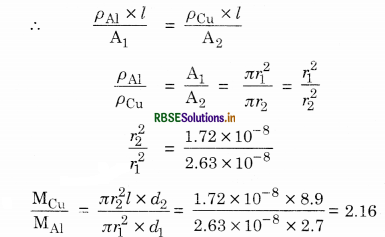
∴ Al wire is lighter. Hence it is preferred for use in overhead cables.
Question 3.17.
What conclusion can you draw from the following observations on a resistor made of alloy manganin:
|
Current I (A) |
Voltage (V) |
|
0.2 |
3.94 |
|
0.4 |
7.87 |
|
0.6 |
11.8 |
|
0.8 |
15.7 |
|
1.0 |
19.7 |
|
2.0 |
39.4 |
|
3.0 |
59.2 |
|
4.0 |
78.2 |
|
5.0 |
98.6 |
|
6.0 |
118.5 |
|
7.0 |
138.2 |
|
8.0 |
158.0 |
Answer:
Since R = \(\frac{3.94}{0.2}=\frac{7.87}{0.4}=\ldots=\frac{138.2}{7.0}=\frac{158.0}{8.0}\)
≈ 19.7 Ω
The shows that Ohm's law is valid to a high accuracy; the resistivity of alloy manganin is nearly independent of temperature.
Question 3.18.
Answer the following questions:
(a) A steady current flows in a metallic conductor of non-uniform cross-section. Say which of these quantities is constant along the conductor-current density, electric field, drift speed?
(b) Is Ohm's law universally applicable for all conducting elements? If not, give examples of elements which do not obey Ohm's law.
(c) A low voltage supply from which one needs high currents must have very low internal resistance. Why?
(d) A high tension (HT) supply of say 6 kV must have a very large internal resistance. Why?
Answer:
(a) Only current (because it is given to be steady!). The rest depends on the area of cross-section inversely.
(b) No, examples of non-ohmic elements-vacuum diode, semiconductor diode.
(c) Because the maximum current drawn from a source = \(\frac{\mathrm{E}}{r}\).
(d) Because, if the circuit is short-circuited (accidentally), the current drawn will exceed safety limits, if internal resistance is not large.

Question 3.19.
Choose the correct alternative:
(a) Alloys of metals usually have (greater/less) resistivity than that of their constituent metals.
(b) Alloys usually have much (lower/higher) temperature coefficients of resistance than pure metals.
(c) The resistivity of alloy manganin (is nearly independent of/increases rapidly) with increase of temperature.
(d) The resistivity of a typical insulator (e.g. amber) is greater than that of a metal by a factor of the order of (1022/103).
Answer:
(a) greater, (b) lower (c) nearly independent of (d) 1022.
Question 3.20.
(a) Given resistors each of resistance R, how will you combine them to get the:
(i) maximum,
(ii) minimum effective resistance? What is the ratio of the maximum to minimum resistance?
(b) Given the resistance of 1 Ω,2 Ω, 3 Ω, how will you combine them to get an equivalent resistance of
(i) \(\frac{11}{3}\) Ω (ii) \(\frac{11}{5}\) Ω (iii) 6 Ω (iv) \(\frac{6}{11}\) Ω?
(c) Determine the equivalent resistance of the following networks:
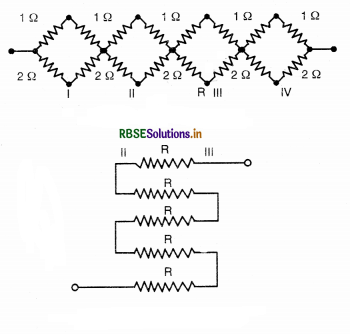
Answer:
(i) In series, the total resistance,
Rs = nR
(ii) In parallel, the total resistance,
Rp = \(\frac{\mathrm{R}}{n}\)
\(\frac{\mathrm{R}_s}{\mathrm{R}_p}=\frac{n \mathrm{R} \times n}{\mathrm{R}}\) = n2
(b) (i) For getting \(\frac{11}{3}\) Ω
Join 1 Ω or 2 Ω in parallel and combination is connected in series with 3 Ω as shown.
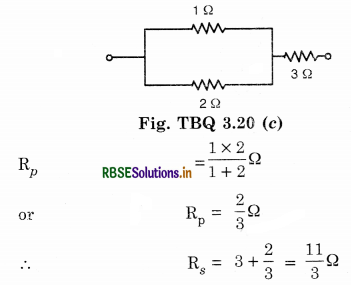
(ii) For getting \(\frac{11}{5}\) Ω
Connect a parallel combination of 2 Ω and 3 Ω in series with 1 Ω
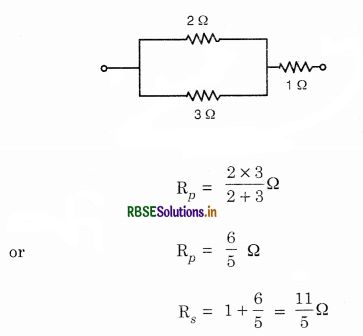
(iii) For getting 6 Ω
All resistances should be connected in series
Rs = 1 Ω + 2 Ω + 3 Ω = 6 Ω
(iv) For getting \(\frac{6}{11}\) Ω
All resistances should be connected in parallel
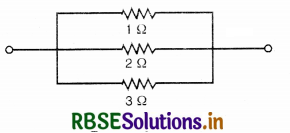
\(\frac{1}{\mathrm{R}_p}=\frac{1}{1}+\frac{1}{2}+\frac{1}{3}=\frac{6+3+2}{6}=\frac{11}{6}\)
Rp = \(\frac{6}{11}\) Ω
(c) For 1st network
Resistance of 1st set is given by
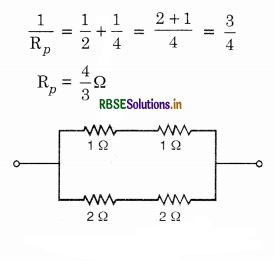
∴ Resistance of all four such sets connected in series
Rs = \(\frac{4}{3}+\frac{4}{3}+\frac{4}{3}+\frac{4}{3}=\frac{16}{3}\) Ω
For 2nd network.
Since all resistance are connected in series.
R5 = R + R + R + R + R = 5R
Question 3.21.
Determine the current drawn from a 12 V supply with internal resistance 0.5 Ω by the following infinite network: Each resistor has 1 Ω resistance.
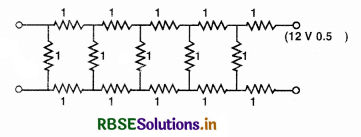
Answer:
Suppose we cut the circuit after the first-section. The combined resistance of remaining circuit will still be the same as original circuit consisting of infinite sections.
Let X = Equivalent resistance of infinite circuit.
Now X and 1 Ω being in parallel the equivalent resistance.
= \(\frac{\mathrm{X}}{\mathrm{X}+1}\)
∴ Equivalent resistance \(\frac{\mathrm{X}}{\mathrm{X}+1}\) is connected in series with two resistance each equal to 1 Ω.
∴ 2 + \(\frac{\mathrm{X}}{\mathrm{X}+1}\) = X
2X + 2 + X = X2 + X
X2 - 2X - 2 = 0
X = \(\frac{2 \pm \sqrt{4+4 \times 2}}{2}=\frac{2 \pm \sqrt{12}}{2}\)
X = 1 ± \(\sqrt{3}\)
Possible value of X = (1 + \(\sqrt{3}\)) Ω = 2.732 Ω
Internal resistances of supply = 0.5 Ω.
Total resistance of circuit = 2.732 + 0.5 = 3.232 Ω.
Current = \(\frac{\mathrm{V}}{\mathrm{R}}=\frac{12}{3.232}\) = 3.713 amp.
Question 3.22.
Figure TBQ 3.22 shows a potentiometer with a cell of 2.0 V and internal resistance 0.40 Ω maintaining a potential drop across the resistor wire AB. A standard cell which maintains a constant e.m.f. of 1.02 V (for very moderate currents up to a few A) gives a balance point at 67.3 cm length of the wire. To ensure very low currents drawn from the standard cell, a very high resistance of 600 kΩ is put in series with it, which is shorted close to the balance point. The standard cell is then replaced by a cell of unknown e.m.f. E and the balance point found similarly turns out to be at 82.3 cm length of wire.
(a) What is the value of E?
(b) What purpose does the high resistance of 600 kΩ have?
(c) Is the balance point affected by this high resistance?
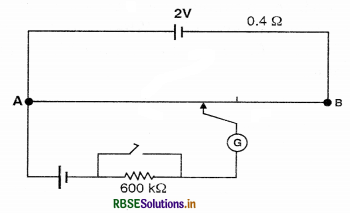
(d) Is the balance point affected by the internal resistance of the drive cell?
(e) Would the method work in the above situation if the driver cell of the potentiometer had an e.m.f. of 1.0 V instead of 2.0 V?
(f) Would the circuit work well for determining extremely small e.m.f. say of the order of a few mV (such as the typical e.m.f., of a thermocouple)? If not, how you modify the circuit?
Answer:
(a) \(\frac{\mathrm{E}_1}{\mathrm{E}_2}=\frac{l_1}{l_2}\)
\(\frac{1.02}{\mathrm{E}_2}=\frac{67.3}{82.3}\)
E2 = 1.25 V
E.M.F. of cell is 1.25 V.
(b) To reduce current through the galvanometer when the movable contact is far from the balance point.
(c) No.
(d) No.
(e) No. If E is greater than the e.m.f. of the driver cell of the potentiometer, there will be no balance point on the wire AB.
(f) The circuit as it is would be unsuitable because the balance point (For E of the order of few mV) will be very close to the end A and the percentage error in measurement will be very large. The circuit is modified by putting a suitable resistor R in series with the wire AB across so that potential drop across AB is only slightly greater than that to be measured. Then the balance point will be at larger length of the wire and the percentage error will be much smaller.
Question 3.23.
Figure TBQ 3.23 shows potentiometer circuit for comparison of two resistances. The balance point with a standard resistor R = 10.0 Ω is found to be 58.3 cm while that with the unknown resistance X is 68.5 cm. Determine the value of X. What would you do if you failed to find a balance point with the given cell of emf E?
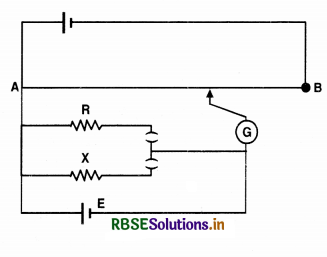
Answer:
\(\frac{\mathrm{R}}{\mathrm{X}}=\frac{l_2}{l_1}=\frac{58.3}{68.5}\)
So X = \(\frac{10 \times 68.5}{58.5}\) = 11.75 Ω
If there is no balance point, it means potential drop across R or X are greater than the potential drop across the potentiometer wire AB. The obvious thing to do is to reduce current in the outside circuit (and hence potential drops across R and X) suitably by putting a series resistor.

Question 3.24.
Figure TBQ 3.24 shows a 2.0 V potentiometer used for the determination of internal resistance of a 1.5 V cell. The balance point of the cell in open circuit is 76.3 cm. When a resistor of 9.5 Ω is used in external circuit of the cell, the balance point shifts to 64.8 cm length of the potentiometer wire. Determine the internal resistance of the cell.
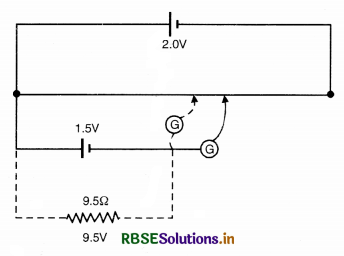
Answer:
r = \(\frac{\mathrm{R}(\mathrm{E}-\mathrm{V})}{\mathrm{V}}=\frac{\mathrm{R}\left(l_1-l_2\right)}{l_2}\)
= \(\frac{9.5(76.3-64.8)}{64.8}\) = 1.685 V = 1.7 V.
SELECTED EXEMPLAR PROBLEMS
MCQ I. (with one correct option)
Question 3.1.
Consider a current-carrying wire (current I) in the shape of a circle. Note that as the current progresses along the wire, the direction of j (current density) changes in an exact manner, while the current I remain unaffected. The agent that is essentially responsible for is
(a) source of e.m.f.
(b) electric field produced by charges accumulated on the surface of wire.
(c) the charges just behind a given segment of wire which pushes them just the right way by repulsion.
(d) the charges ahead.
Answer:
(b) current density j\(\left(\frac{\mathrm{I}}{\mathrm{A}}\right)\) is also directed along E and the relation is:
j = σE.
Question 3.2.
A resistance R is to be measured using a meter bridge. Student chooses the standard resistance S to be 100 Ω. He finds the null point at l1 = 2.9 cm. He is told to attempt to improve the accuracy. Which of the following is a useful way?
(a) He should measure l1 more accurately.
(b) He should change S to 1000 Ω and repeat the experiment.
(c) He should change S to 3 Ω and repeat the experiment.
(d) He should give up hope of a more accurate measurement with a meter bridge.
Answer:
(c)
R = \(\frac{l_1}{100-l_1}S = \frac{2.9 \times 100}{100-2.9}=\frac{100 \times 2.9}{97.1}\) = 3 Ω

Question 3.3.
Two cells of emf's approximately 5V and 10V are to be accurately compared using a potentiometer of length 400 cm.
(a) The battery that runs the potentiometer should have voltage of 8V.
(b) The battery of potentiometer can have a voltage of 15V and R adjusted so that the potential drop across the wire slightly exceeds 10V.
(c) The first portion of 50 cm of wire itself should have a potential drop of 10V.
(d) Potentiometer is usually used for comparing resistances and not voltages.
Answer:
(b) In potentiometer experiment, the e.m.f. of the cell can be measured, if potential drop along the potentiometer wire is greater than the e.m.f. of the cell. Here we have two values of e.m.f.s of the cells i.e. 5V and 10V. So potential drop along the potentiometer wire must be more than 10V.
Question 3.4.
A metal rod of length 10 cm and a rectangular cross-section of 1 cm x \(\frac{1}{2}\) cm is connected to a battery across opposite faces.
(a) maximum when the battery is connected across 1 cm x \(\frac{1}{2}\) cm faces.
(b) maximum when the battery is connected across 10 cm x 1 cm faces.
(c) maximum when the battery is connected across 10 cm x \(\frac{1}{2}\) cm
(d) The same irrespective of the three faces.
Answer:
(a)
Since R = ρ\(\frac{l}{\mathrm{~A}}\)
So R will be higher, if l is large and A is small.
Question 3.5.
Which of the following characteristics of electrons determines the current in a conductor?
(a) Drift velocity alone.
(b) Thermal velocity alone.
(c) Both drift velocity and thermal velocity.
(d) Neither drift nor thermal velocity.
Answer:
(a) Since I = neAvd or I ∝ vd
So the current in a conductor is determined by drift velocity alone.
MCQ II. (with more than one correct option)
Question 3.6.
Kirchhoff's junction rule is a reflection of
(a) conservation of current density vector.
(b) conservation of charge.
(c) the fact that the momentum with which a charged particle approaches a junction is unchanged particle approaches a junction is unchanged (as a vector) as the charged particle leaves the junction.
(d) the fact that there is no accumulation of charges at a junction.
Answer:
(b) and (d)
Kirchhoff's law is based on conservation of charge and the fact that there is no accumulation of charges at a junction.

Question 3.7.
Temperature dependence of resistivity ρ (T) of semiconductors, insulators and metals is significantly based on the following factors:
(a) number of charge carriers can change with temperature T.
(b) time interval between two successive collisions can depend on T.
(c) length of material can be a function of T.
(d) mass of carriers is a function of T.
Answer:
(a) and (b)
Resistivity of a condutor ρ = \(\frac{m}{n e^2 \tau}\)
So as temperature changes n and τ change.
Question 3.8.
The measurement of an unknown resistance R is to be carried out using Wheatstone bridge (see Fig. EP 3.8.). Two students perform an experiment in two ways. The first student takes R2 = 10 Ω and R1 = 5 Ω. The other student takes R2 = 1000 Ω and R1 = 500 Ω. In the standard arm, both take R3 = 5 Ω. Both find R = \(\frac{\mathrm{R}_2}{\mathrm{R}_1}\)R3 = 10 Ω within errors.
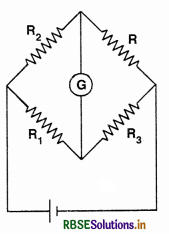
(a) The errors of measurement of the two students are the same.
(b) Errors of measurement do depend on the accuracy with which R2 and R1 can be measured.
(c) If the student uses large values of R2 and R1, the currents through the arms will be feeble. This will make determination of null point accurately more difficult.
(d) Wheatstone bridge is a very accurate instrument and has no errors of measurement.
Answer:
(b) and (c)
From Wheatstone bridge principle, we have
\(\frac{\mathrm{R}_2}{\mathrm{R}}=\frac{\mathrm{R}_1}{\mathrm{R}_3}\)
or R = R3 x \(\frac{\mathrm{R}_2}{\mathrm{R}_1}\)
Putting the values of R3, R1 and R2 for both students, we find that R = 10 Ω
Thus we find that the bridge is most sensitive and accurate if resistances are of the same value.
So errors of measurement of the two students depend on the accuracy and sensitivity of the bridge, which in turn depends on the accuracy with which R2 and R1 can be measured. When R2 and R1 are large, the current through the arms of bridge is very weak. This will make determination of null point accurately more difficult.

Question 3.9.
In a meter bridge the point D is a neutral point (Fig. EP 3.9).
(a) The meter bridge can have no other neutral point for this set of resistances.
(b) When the jockey contacts a point on meter wire left of D, current flows to B from the wire.
(c) When the jockey contacts a point on the meter wire to the right of D, current flows from D to the wire through galvanometer.
(d) When R is increased, the neutral point shifts to left.
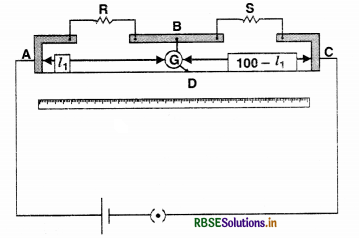
Answer:
(a), (b) and (c).
At neutral point D
\(\frac{\mathrm{R}}{\mathrm{S}}=\frac{l_1}{100-l_1}\)
So there is only one value of l1 for which we get neutral point.
When jockey contacts at point on the wire left of D, the potential drop across AD is less than potential drop across AB, which brings the potential of point D more than that of B, hence current flows from D to B.
When jockey contacts at point on the wire right of D, the reverse is true.
Very Short Answer Type Questions
Question 3.10.
Is the motion of charge across junction momentum conserving? Why or Why not?
Answer:
When an electron approaches a junction, in addition to the uniform electric field E that it normally faces which keeps the drift velocity fixed as
vd = \(\frac{e \mathrm{E}}{m} \tau\)
There are accumulation of charges on the surface of wires at the junction. These produce electric fields. These fields alter direction of momentum. Hence, the motion of a charge across junction is not momentum-conserving.
Question 3.11.
The relaxation time τ is nearly independent of applied E field whereas it changes significantly with temperature T. First fact is (in part) responsible for Ohm's law whereas the second fact leads to variation of ρ with temperature. Elaborate why?
Answer:
Since drift velocity of electrons is given by
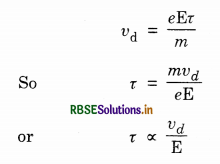
We find that relaxation time τ depends on velocities of electrons and ions and electric field. Applied electric field affects the velocity of electrons but this effect is negligibly small. This supports Ohm's law. On the other hand, change in T affects velocities of electrons and ions significantly as resistivity ρ of metal or conductor is given by
ρ = \(\frac{1}{\sigma}=\frac{m}{n e^2 \tau}\)
Question 3.12.
What are the advantages of the null-point method in a Wheatstone bridge? What additional measurements would be required to calculate Runknown by any other method?
Answer:
The advantage of null method in a Wheatstone bridge is that the resistance of galvanometer does not affect the balance point and there is no need to determine the current in resistances and galvanometer and internal resistance of the galvanometer. Hence it is an easy and convenient method.
We can also calculate the value of Runknown by Kirchhoff's rules but we need additional measurements of all the currents in resistances and galvanometer and internal resistance of the galvanometer.

Question 3.13.
What is the advantages of using thick metallic strips to join wires in a potentiometer?
Answer:
The resistance of thick metallic strips is negligible and hence do not affect the resistance of the potentiometer wire. So we can increase the length of potentiometer can increase d which leads to accurate measurement.
Question 3.14.
For wiring in the home, one uses Cu wires or Al wires. What considerations are involved in this?
Answer:
Two considerations are involved
1. cost of metal used for wires
2. good conductivity of metal used for wires conductivity of silver is highest but it cannot be used due to its high cost. Cu and Al are the next best conductors and are used for wiring in the home.
Question 3.15.
Why are alloys used for making standard resistance coils?
Answer:
Alloys are used for making standard resistance coils as they have low value of temperature coefficient of resistance and high resistivity.
Question 3.16.
Power P is to be delivered to a device via transmission cables having resistance Rc. If V is the voltage across R and I the current through it, find the power wasted and how can it be reduced.
Answer:
Power wasted Pc = I2Rc = \(\frac{\mathrm{P}^2}{\mathrm{~V}^2}\)Rc
To reduce Pc, power should be transmitted at high voltage.
Question 3.17.
AB is a potentiometer wire (Fig. EP 3.17). if the value of R is increased, in which direction will the balance point J shift?
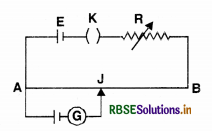
Answer:
When R is increased, the current through the wire will decrease, hence the potential gradient \(\left(\frac{\mathrm{V}}{l}\right)\) will also decrease. Hence there is increase in balance length. So the point J will shift towards B.
Question 3.18.
While doing an experiment with potentiometer (Fig EP 3.18) it was found that the deflection is one-sided and (i) the deflection decreased while moving from one end A of the wire to the end B; (ii) the deflection increased, while the jockey was moved towards the end B.
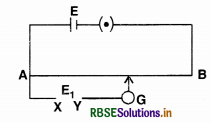
(i) Which terminal +ve or -ve of the cell E1, is connected at X in case (i) and how is E1 related to E?
(ii) Which terminal of the cell E1 is connected at X in case (ii)?
Answer:
Since in this experiment, the deflection is one sided, it means E1 > E in the galvanometer.
(i) Since deflection in the galvanometer decreases while moving from one end A of the wire to the end B, it means positive of E1 connected to a and negative of E1 is connected to B.
(ii) Since deflection in the galvanometer increases while moving from one end A of the wire to end B, it means negative of E1 is connected to A and positive of E1 is connected to B.

Question 3.19.
A cell of e.m.f. E and internal resistance r is connected across an external resistance R. Plot a graph showing the variation of P.D. across R, verses R.
Answer:
Since V = IR
or V = \(\frac{\mathrm{E}}{\mathrm{R}+r}\) [∵ I = \(\frac{\mathrm{E}}{\mathrm{R}+r}\)]
or V = \(\frac{\mathrm{E}}{1+\frac{r}{\mathrm{R}}}\)
So as R increases, V also increases.
Graph between V and R is as shown in the figure EP 3.19.
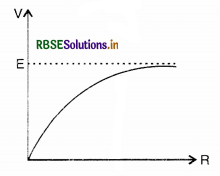
Short Answer Type Questions
Question 3.20.
First a set of n equal resitors of R each are connected in series to a battery of e.m.f. E and internal resistance R. A current I is observed to flow. Then the n resistors are connected in parallel to the same battery. It is observed that the current is increased 10 times. What is 'n'?
Answer:
In series combination of n-resistors the current I is given by
I = \(\frac{\mathrm{E}}{\mathrm{R}+n \mathrm{R}}=\frac{\mathrm{E}}{(n+1) \mathrm{R}}\)
In parallel combination of n-resistors, the current I' is given by
I' = \(\frac{\mathrm{E}}{\mathrm{R}+\frac{\mathrm{R}}{n}}=\frac{n \mathrm{E}}{(n+1) \mathrm{R}}\)
Given I' = 10I
∴ \(\frac{n \mathrm{E}}{(n+1) \mathrm{R}}=\frac{10 \mathrm{E}}{(n+1) \mathrm{R}}\)
∴ n = 10
Question 3.21.
The circuit in Fig.EP 3.21 shows two cells connected in opposition to each other. Cell E1 is of emf 6V and internal resistance 2 Ω; the cell E2 is of e.m.f. 4V and internal resistance 8 Ω. Find the potential difference between the points A and B.
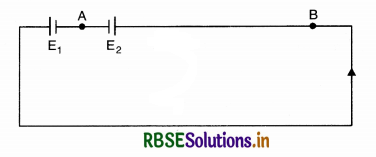
Answer:
Given E1 = 6V, r1 = 2 Ω
E2 = 4V, r2 = 8 Ω
The current in the circuit is given by
I = \(\frac{\mathrm{E}_1-\mathrm{E}_2}{r_1+r_2}\)
= \(\frac{6-4}{2+8}\) = 0.2A
Potential difference between points A and B
= terminal voltage of cell E1
= E1 - Ir1
= 6 - (0.2) (2) = 5.6V
Question 3.22.
Two cells of the same e.m.f. E but internal resistance r1 and r2 are connected in series to an external resistor R (Fig. EP 3.22). What should be the value of R so that the potential difference across the terminals of the first cell becomes zero?
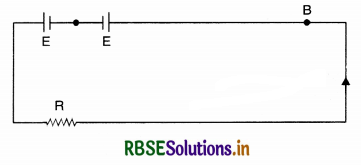
Answer:
The electric current in the circuit is given by
I = \(\frac{\mathrm{E}+\mathrm{E}}{\mathrm{R}+r_1+r_2}=\frac{2 \mathrm{E}}{\mathrm{R}+r_1+r_2}\)
Potential difference across the terminals of first cell will be zero.
i.e. V1 = 0
if E - Ir1 = 0
or E - \(\frac{2 \mathrm{E} r_1}{\mathrm{R}+r_1+r_2}\) = 0
or E = \(\frac{2 \mathrm{E} r_1}{\mathrm{R}+r_1+r_2}\)
or R + r1 + r2 = 2r1
or R = r1 - r2

Question 3.23.
Suppose there is a circuit consisting of only resistances and batteries. Suppose one is to double (or increase it to n-times) all voltages and all resistances. Show that currents are unaltered.
Answer:
Let Eeff is the effective e.m.f. of n-batteries Reff is the effective internal resistance of n-batteries R is the external resistance in the circuit as shown in the figure EP 3.23.
∴ current in the circuit
I = \(\frac{\mathrm{E}_{e f f}}{\mathrm{R}+\mathrm{R}_{e f f}}\) ...................(i)
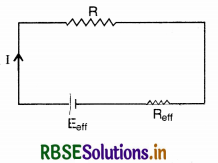
When all the resistances and effective voltages are increased n-times, then we have
Eeff' = nEeff, R'eff = nReff and R' = nR
∴ Current in the circuit will be:
I' = \(\frac{\mathrm{E}_{e f f}^{\prime}}{\mathrm{R}^{\prime}+\mathrm{R}_{e f f}^{\prime}}\)
= \(\frac{n \mathrm{E}_{e f f}}{n \mathrm{R}+n \mathrm{R}_{e f f}}\)
= \(\frac{\mathrm{E}_{e f f}}{\mathrm{R}+\mathrm{R}_{e f f}}\) = I
Thus current remains unaltered.
Long Answer Type Questions
Question 3.24.
A room has AC runs for 5 hours a day at a voltage of 220V. The wiring of the room consists of Cu of 1mm radius and a length of 10m. Power consumption per day is 10 commercial units. What fraction of it goes in the joule heating in wires? What would happen if the wiring is made of aluminum of the same dimensions?
[ρcu = 1.7 x 10-8 Ωm, ρAl = 2.7 x 10-8 Ωm]
Answer:
Power consumption per day = 10 kWh
Time for which ac runs per day = 5h
∴ Power consumption
P = \(\frac{10}{5}\) = 2kW = 2000W = 2000 Js-1
∴ I = \(\frac{\mathrm{P}}{\mathrm{V}}=\frac{2000}{220}\) ≃ aA
Power loss in copper wire
Pcu = RcuI2 = ρ\(\frac{l}{\mathrm{~A}}\)I2
= 1.7 x 10-8 x \(\frac{10}{\pi \times 10^{-6}}\) x 92 = 4 Js-1
Fraction of power loss in Cu wire = \(\frac{4}{2000}\)
= \(\frac{2}{1000}\) x 100 = 2%
Power loss in Al wire
PAl = \(\frac{\rho_{A l} l \mathrm{I}^2}{\pi r^2}=\frac{2.7 \times 10^{-8} \times 10}{\pi \times\left(10^{-3}\right)^2}\) x 92 = 6.4 Js-1
Power loss in Al wire = \(\frac{6.4}{2000}\) x 100 = 0.32%

Question 3.25.
(a) Consider circuit in Fig. EP 3.25. How much energy is absorbed by electrons from the initial state of no current (ignore thermal motion) to the state of drift velocity?
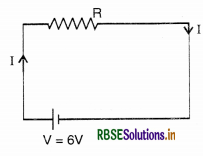
(b) Electrons give up energy at the rate of RI2 per second to the thermal energy. What time scale would one associate with energy in problem? (a)? n = no.of electrons/volume = 1029/m3, length of circuit = 10 cm, cross-section = (1 mm)2
Answer:
(a) From Ohm's law, current I in the circuit is
I = \(\frac{\mathrm{V}}{\mathrm{R}}=\frac{6}{6}\) = 1A
Also I = neAvd
∴ vd = \(\frac{\mathrm{I}}{n e \mathrm{~A}}=\frac{1}{10^{29} \times 1.6 \times 10^{-19} \times 10^{-6}}\)
= \(\frac{1}{1.6}\) x 10-4 ms-1
Number of elctrons in the wire = nAl
Therefore, energy absorbed in the form of kE is given by
E = \(\frac{1}{2}\)mevd2 (nAl)
= \(\frac{1}{2}\) x (9.1 x 10-31) (\(\frac{1}{1.6}\) x 10-4)2 x 1029 x 10-6 x 10-1
or E = 2 x 10-17 J
(b) Power loss P = I2R
= 12 x 6 = 6W = 6 Js-1
Since E = P x t2
∴ t = \(\frac{\mathrm{E}}{\mathrm{P}}=\frac{2 \times 10^{-17}}{6}\) ≃ 10-17 s

- RBSE Class 12 Physics Notes Chapter 2 स्थिर वैद्युत विभव तथा धारिता
- RBSE Class 12 Physics Notes Chapter 3 विद्युत धारा
- RBSE Class 12 Physics Notes Chapter 4 गतिमान आवेश और चुंबकत्व
- RBSE Class 12 Physics Notes Chapter 5 चुंबकत्व एवं द्रव्य
- RBSE Class 12 Physics Notes Chapter 6 वैद्युत चुंबकीय प्रेरण
- RBSE Class 12 Physics Notes Chapter 7 प्रत्यावर्ती धारा
- RBSE Class 12 Physics Notes Chapter 8 वैद्युतचुंबकीय तरंगें
- RBSE Class 12 Physics Notes Chapter 9 किरण प्रकाशिकी एवं प्रकाशिक यंत्र
- RBSE Class 12 Physics Notes Chapter 10 तरंग-प्रकाशिकी
- RBSE Class 12 Physics Notes Chapter 11 विकिरण तथा द्रव्य की द्वैत प्रकृति
- RBSE Class 12 Physics Notes Chapter 12 परमाणु